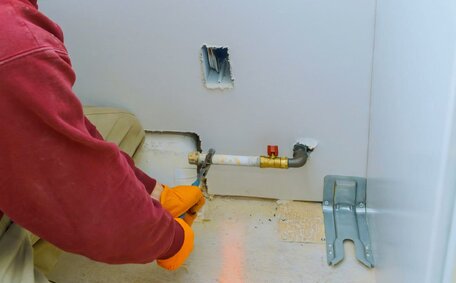Why Pipes Freeze
Pipes freeze when temperatures plummet below 0°C, as water turns to ice and expands, exerting intense pressure on the inner walls of the pipes.
This pressure, if high enough, can cause pipes to burst.
In areas like Drummoyne where winter temperatures can drop below 0°C, homeowners need to take measures to insulate and protect water pipes from freezing, particularly those located in unheated spaces like attics, basements and crawl spaces. Understanding how to prevent pipes from freezing can reduce unexpected plumbing issues, keeping your plumbing in top shape.
Temperatures That Cause Freezing
Pipes are at risk of freezing when temperatures fall below 0°C. In the Drummoyne area, overnight lows often fall into the single digits Celsius, raising concerns about what to do when your pipes face freezing conditions during the winter months of June through August.
Outdoor hose bibs and water pipes in unheated areas like crawl spaces, attics, garages, and basements are highly susceptible to freezing. Yet even pipes situated within your walls, in draughty rooms, or concealed behind cabinets attached to exterior walls can succumb to the icy grip, transforming freely flowing water to frosty, freezing pipes.
To prevent burst pipes, Drummoyne homeowners must proactively insulate their plumbing, employ heat sources and ensure water circulation.
Parts of a Home Vulnerable to Freezing
The areas of a home most prone to freezing water in pipes during cold weather are:
- Attics - Pipes through uninsulated or unheated attic areas frequently freeze, especially with insufficient thermal barrier.
- Basements and crawl spaces - Like attics, these unheated spaces often allow pipes to freeze due to cold air infiltration.
- Garages - As with other unheated areas, garages permit cold air entry, making pipes likely freeze.
- Exterior walls - Any pipes located on or running through exterior walls have exposure to freezing outdoor temperatures.
- Kitchen bathroom spaces - Even pipes hidden within the recesses of these areas can succumb to the cold, particularly when mounted to an exterior wall or subject to drafts filtering into your abode.
Older homes in Drummoyne often lack adequate insulation compared to newer constructions, putting them at greater risk of pipe freeze during winter. Paying special attention to how do your pipes can be protected in these vulnerable areas is crucial.
Preventing Pipes From Freezing
Looking to insulate your pipes to prevent freezing during cold blasts? Homeowners can use several effective measures on how to prevent:
- Insulate pipes in unheated areas like the attic crawl space and basements, employing insulation wraps or foam covers.
- Seal air leaks and drafts to safeguard and prevent your pipes from the cold air entering your dwelling.
- Set a consistent thermostat temperature between 15-20°C when away to stop your pipes from freezing.
- Throw open cabinet doors to circulate warm air around your pipes water on exterior walls.
- Make sure your water pipes are drained from and disconnect garden hoses, shut off and empty any isolated drain line branch lines.
- Allow a small drip of water to run overnight to keep a consistent flow and pressure.
- Use portable heaters or heat cables on exposed pipes to prevent freezing, ensuring they comply with safety standards.
In extreme cold, vigilant monitoring and proactive adjustment is key. Know the location of your main shutoff valve in case immediate pipe draining is needed.
Insulating Pipes
Installing insulation around water pipes, as Galeotafiore Plumbing Experts said, is an effective and affordable method to ensure their safety, preventing freezing temperatures from seeping into your home. Insulation erects a barricade between the warm air inside your pipes and the frigid external temperatures.
Common insulation materials used are those designed to insulate a water pipe:
- Pipe foam sleeves - Pre-slit foam tubes that wrap snugly around pipes.
- Fibreglass strips - Flexible strips that adhere around pipes.
- Pipe wrapping - Pliable plastic wraps that fully cover pipes.
Insulating key areas can protect pipes in unheated spaces and against exterior walls from freezing. Ensure every supply line, tap, valve, and connection is covered with insulation to guard against the chill.
For Sydney’s climate, investing in pipe insulation with a wall thickness of about 10mm is ideal. Seal seams thoroughly with adhesive/caulk to prevent heat loss.
Installing pipe insulation can help as an easy, low-cost DIY project. Contemplating how can best protect your pipes? Drummoyne homeowners might consider utilising professional plumbing services for proper installation and weatherproofing of insulation.
Maintaining Heat
Learning how to keep pipes warm is essential for their protection. Drummoyne homeowners should maintain your thermostat set no lower than 15°C to keep their home warm, even while away. Exercise increased vigilance throughout any bracing cold snap occurrences.
Also helpful is allowing warm air to reach vulnerable pipes by:
- Opening cabinet doors where pipes are located outside your interior living spaces
- Keeping attic hatches open can prevent pipes freezing by allowing rising warm air to circulate
- Using portable space heaters to directly warm uninsulated crawl spaces or basements
Maintaining consistent heating throughout your home ensures pipes stay warm, reducing the chance of freezing and protecting water temperature and pressure. Inexpensive to run, these simple measures offer reliable protection.
Sealing Drafts
Sealing any air leaks or drafts around your house helps prevent cold air intrusion that can freeze pipes. Check areas like:
- Windows and doors - Use weatherstripping to seal gaps and cracks.
- Attic hatches/doors - Ensure hatches seal tightly when closed.
- Outlets and switches - Foam sealant behind these stops cold air flow through walls.
- Pipe penetrations - Seal spaces around pipes where they enter exterior walls.
Also seal any foundation cracks or gaps around dryer vents, AC units and where cables/wires penetrate. Eliminating drafts maintains warmer indoor temps around pipes.
Letting Faucets Drip
Letting your faucets drip during extreme cold is an effective way to prevent pipes from freezing. A steady trickle of water through the pipes maintains pressure, helping to prevent freezing. Stationary water is more liable to become ice when water freezes than water that is in motion.
To employ this method, turn faucet on to the cold tap for your taps near exterior walls. Adjust the tap to a slow constant drip near water exits at roughly one drip per second. This steady flow maintains water pressure and motion, preventing stagnation in freezing temperatures.
Allowing multiple taps to drip helps mitigate downstream freezing risk by keeping water in continuous movement. While slightly wasteful of water, it provides peace of mind by ensuring critical water flow and pressure is upheld during cold snaps.
What To Do If Pipes Freeze
If you discover frozen pipes, act quickly but cautiously. If you discover frozen pipes, act quickly but cautiously. Do use approved heating devices for thawing to avoid the risks associated with an open flame, which can damage pipes. Ensure heating devices do not directly touch pipes and monitor temperatures carefully to prevent overheating. Once you thaw frozen pipes and they have been remedied, examine all faucets for appropriate water flow.
Immediately locate and turn off your main water shutoff valve to stop water flow through the frozen section. Apply heat gently and steadily to the frozen area using hair dryer, heating pad or space heater to progressively thaw pipe ice. In the event of a burst, disconnect the water at the main valve and promptly contact a licensed plumber in Drummoyne for a professional assessment and repairs.
Locating and Shutting Off Water
It is paramount for Drummoyne homeowners to be aware of the main water shutoff valve’s location on your property. This allows you to quickly shut off the main water supply when necessary, such as in the event of a frozen pipes burst, leaving you with no water or another emergency.
The main shutoff valve is typically located where the main water line enters your home, becoming a cornerstone for maintaining your water supply lines. Valves are typically near a water metre. They enable you to isolate the entire home’s water system with a simple quarter-turn.
During the winter months, it’s important to delineate what do if a freeze occurs, ensuring everyone understands the protocol in the same way they would recognise a fire exit. Post clear diagrams showing its location if helpful. That way, if you discover a burst pipe, you can immediately shut off water flow to prevent flooding issues and decide on what to do next while the pipe gets repaired by a professional Drummoyne plumbing service.
Thawing Frozen Pipes
If you discover a frozen pipe, it is crucial to thaw it slowly and safely to avoid pipe damage. Then utilise methods on how to thaw them, like a hair dryer or other gentle heat source, such as a heating pad or towel soaked in warm water, gently moving the heat for even warming of the pipe. If you discover a frozen pipe, it is crucial to thaw it slowly and safely to avoid pipe damage.
Turn off the main water supply first to relieve pressure. Avoid applying high heat or open flames which can damage plastic pipes. Focus on how thaw them effectively once the water flow is restored. If a section has already burst, stop thawing and contact a licenced Sydney plumber immediately.
Repairing Burst Pipes
A burst pipe is an emergency that demands immediate action to prevent significant water damage. The first step is to identify and shut off the main water supply to prevent any further damage to your pipes. Taking this action will cease water flow, mitigating any pipe can cause severe property damage, and allowing you time to address the issue and efficiently thaw if necessary.
Subject to the terms and conditions of the pipe material and location, certain minor ruptures can be momentarily mended until lasting fixes are carried out. But it’s crucial to seek professional advice to combat your pipes freezing, calling a licenced Drummoyne plumber for inspection and repair as soon as possible.
For burst pipes your walls conceal or in difficult to access areas, drywall may need to be cut open to access the damaged sections. Plumbers have the tools and expertise to locate pipe bursts and perform necessary repairs to restore proper water flow and waterproof surroundings.
Contact Drummoyne’s emergency plumbing team on 1300 349 338 or jobs@drummoyneplumbingservices.com.au for 24/7 support with burst pipe issues. Protecting your home is our top priority.






